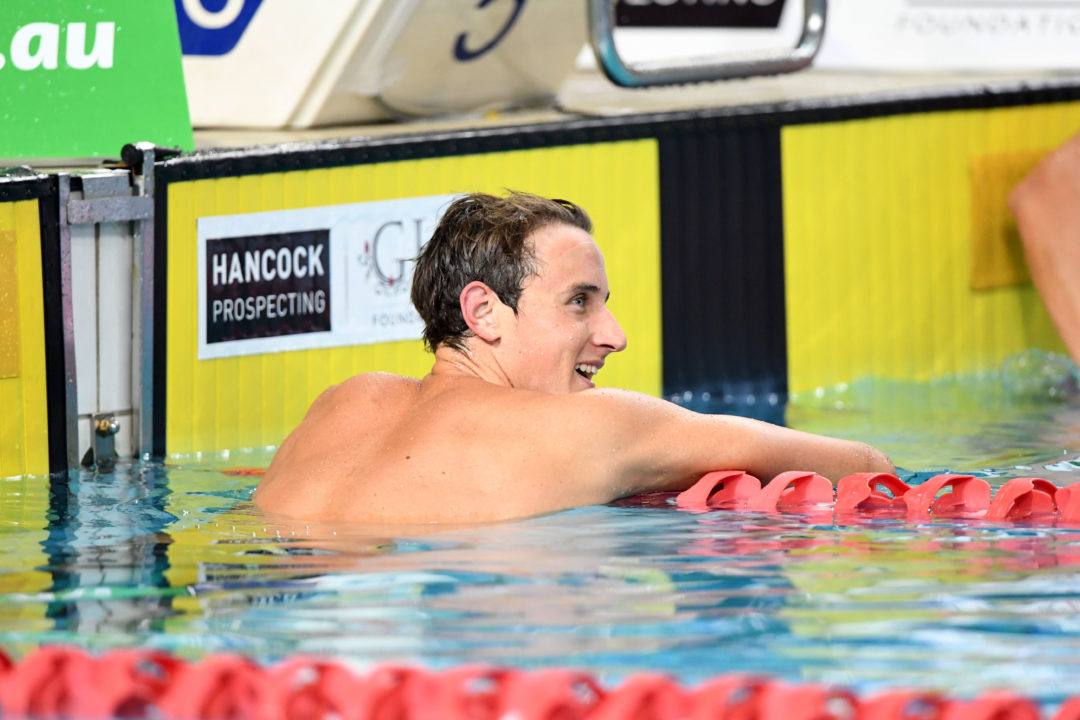Australian 29-year-old Cameron McEvoy had arguably the swim of the meet at the Australian Trials last week in Melbourne, rocketing to a 21.27 in prelims of the men’s 50 free to establish the top time in the world this year by a huge margin. Not only was it a terrific swim that makes him a top contender for gold this summer at the World Championships in Fukuoka, the swim also marks Mcevoy’s first lifetime best in the event since 2016.
We’ve already published a couple articles on the swim, which you can view below:
- Cameron McEvoy Posts 21.27 50 Free in Aussie Trials Prelims, #10 Performer All-Time
- How Rock Climbing Helped Cameron McEvoy’s Career Resurgence at Age 29
This post is going to have a slightly different focus than our previous coverage of McEvoy and his swim. We’re going to take a look at the race itself and try and analyze what changes he’s made that contributed to his improvement.
We can start this process by citing our recent article on how McEvoy’s discovery of rock climbing contributed to his re-found love of swimming and shifted his perspective on strength training. In that article, McEvoy is quoted as saying through the increased strength he had gained from rock climbing, his time from a dive to 15 meters had reduced by 0.4 seconds, which is a truly massive improvement for a swimmer of his caliber.
I bring that up first because McEvoy’s start on his 21.27 50 free a few days ago was exceptional, granting further evidence towards McEvoy’s claim that his shift in strength training and conditioning has improved his start. What I find so interesting, however, is that as good as his start was, the thing that truly set him apart from the rest of the field in that race was the manner in which McEovy maintained his speed from the start as he broke out and started swimming.
Take a look at the race video below again. When McEvoy hits the surface to take his first stroke, it appears he has a slim lead over the field. What I’m focusing in on is the first 4-5 stroke cycles. Watch how much he pulls away from every other swimmer in the heat just in those first 8-ish strokes.
Cam McEvoy 21.27 in the heats pic.twitter.com/6DQzWvAYRi
— Nick (@nicktehwalrus) June 18, 2023
Given what McEvoy said in the rock climbing article, it appears to me that one of the things he’s been able to do is not only improve his start speed through increased power, better entry angle, improved underwaters, etc., but he’s figured out how to hold onto his speed from the start better than anyone else, certainly anyone else in that heat. In short, what I’m seeing is that the main contributor to McEvoy’s breakthrough swim was in fact his start, and, going hand-in-hand with the start, his breakout.
Watch the video again. Of course, the camera angle could play a role in this, however, it looks like McEvoy stops building his lead over the field somewhere around 30 meters into the race. At the very least, if he did continue building his lead past that point, the rate at which he was pulling away from the field had slowed down significantly. This lends itself to the idea that McEvoy’s main means of improvement have come from his maximizing speed off the start.
While finding good race video of McEvoy from previous years is proving to be surprisingly difficult, if you’re a swim nerd you should definitely take the time to peruse Cameron McEvoy’s Instagram account sometime. If one thing is clear it’s that McEvoy takes great care with and puts a ton of thought into his training from a technical standpoint.
I’ve included my personal favorite post of his below. It shows a comparison between his freestyle strokes when he’s working on training the second 50m for the 100, the middle of the first 50m of the 100, and an all-out 50m pace. In his caption he explains the key differences you’ll notice between the strokes.

Also showing- especially to young swimmers – that plateaus do exist even for pros (his previous PB was 7 years ago). Obviously, a 13-y old should be a bit concerned if he doesn’t improve before he is 20-y….However, too many kiddos are obsessed (did I cut time?) w immediate outcome and forget the long term and very rewarding process.
Cam MacEvoy always has wonderful technique.
That 47.04 in 2026 was breathtakingly beautiful.
2026? You mean 2016
must be a prediction
Hopefully in 2026 he is going faster then 47.04 and breaking his Aus record
Would love to see more stats in the 50m free.
Obviously reaction time but time to 15 and 25, last 25 and last 15 would be interesting to see and compare where peoples strengths are.
Some footage here of 2016 Australian Champs where Cam went 21.44.
https://youtu.be/lpTeDMIA538
cam shining at the national past time – love to see it
Great analysis. I didn’t realise how good his immediate post-surfacing was until you pointed it out. I think it is partially aided by the camera angle but he does seem to gain almost a full body length between 15-30m and then holds it.
Great to see someone who’s had significant struggles getting some PBs!
Great article!
I’m wondering how his times for each section of the race compare to others who have been 21 low. It’s hard to tell whether he’s best at the start (like Dressel), middle (like Fratus(?)), or end (like Ervin(?)).
Steffano Nurra was really a gift, wasn’t he?
I’ll see if I can figure that out.
Great piece!